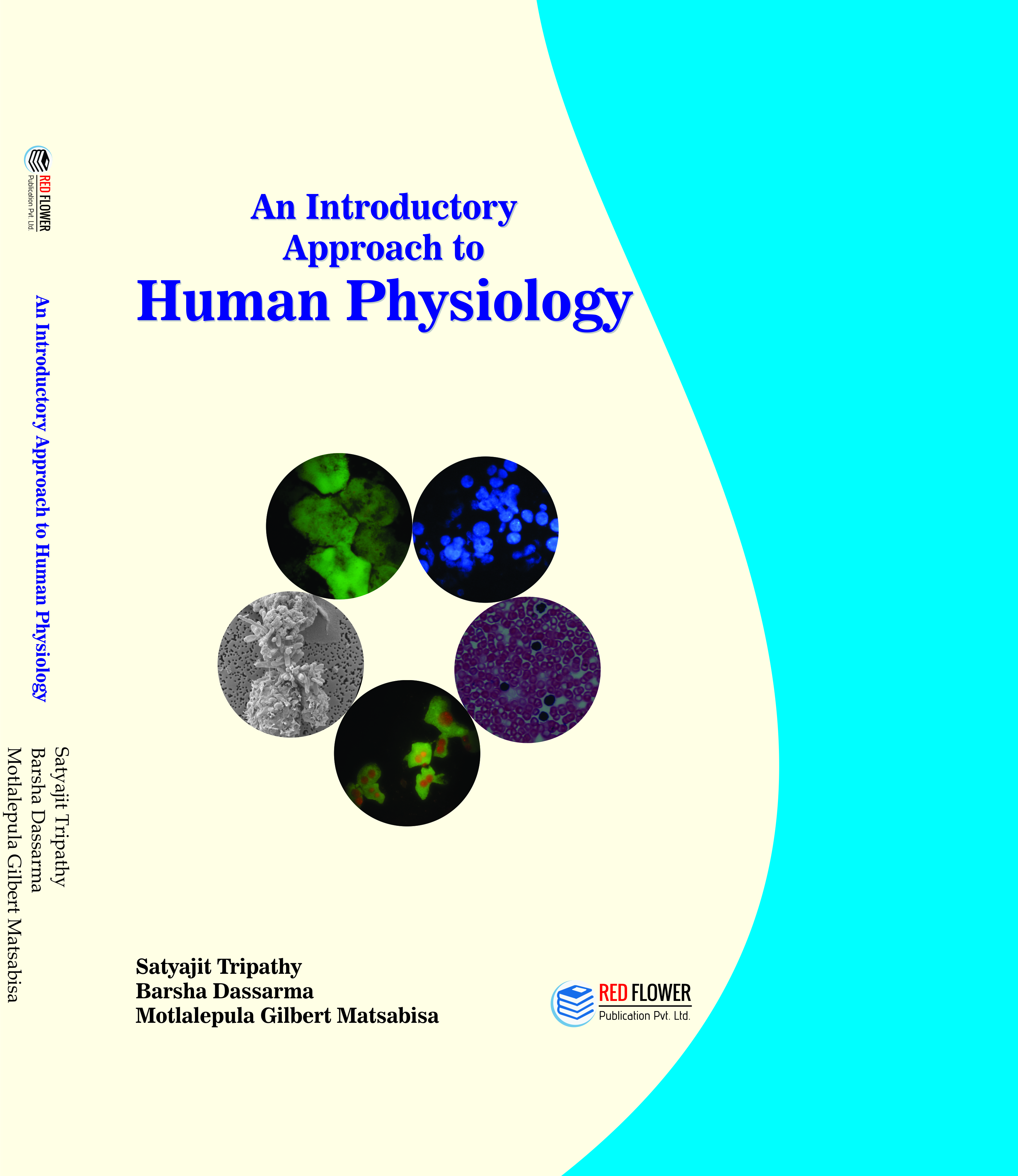An Introductory Approach to Human Physiology
Editor(s)/Author:
Satyajit Tripathy, Barsha Dasssarma, Motlalpula Gibert Matsabisa
Available
2021-12-01

Satyajit Tripathy, Barsha Dasssarma, Motlalpula Gibert Matsabisa
Available
2021-12-01

Human Physiology is the study of normal function within human body. This sub-section of biology, wraps several topics like organs, tissue, cells, biological compounds, and the way of interaction to make life possible. This textbook provides an introductory explanation of the workings of the human body, with an effort to draw connections between the body systems and explain their interdependencies. An outline for the book is to understand how the body maintains steadiness within each system and environment. This is for a college-level course. The requirement for having a concise book, which will give a basic idea about human body of BDS, Nursing and undergraduate students, has been felt. Authors have tried to reach with the idea of fulfilling the requirements on the present-day courses.
1. Cell Physiology 1-18
ï¶ Cell
ï¶ Structure of the cell
ï¶ Nucleus
ï¶ Cytoplasm
ï¶ Secretory granules
ï¶ Cell Junctions
ï¶ Cell Transport
ï¶ Homeostasis
ï¶ Acid-base homeostasis
2. Blood and body defense 19-57
ï¶ Composition of the Blood
ï¶ Plasma proteins
ï¶ Hematopoiesis
ï¶ Red Blood cell indices
ï¶ Haemostasis
ï¶ Blood types
ï¶ Lymphatic System and Lymph
ï¶ Blood and immune system
3. Cardiovascular System 58-84
ï¶ Origin and development
ï¶ Atria and ventricles
ï¶ Cardiac valves
ï¶ Heart Sound
ï¶ Blood Vessels
ï¶ Arteries and Arterioles
ï¶ Capillaries
ï¶ Veins and Venules
ï¶ Blood supply to the heart
ï¶ Heart Beat
ï¶ Heart rate or Pulse rate
ï¶ Stroke Volume
ï¶ Cardiac Output
ï¶ Electrocardiogram (ECG)
ï¶ Control of Blood Pressure
ï¶ Heart disease
4. Gastrointestinal system 85-119
ï¶ Introduction to the gastrointestinal system
ï¶ Basic structure and Physiological activity
ï¶ Individual components of the gastrointestinal system
ï¶ Mechanism of Acid Secretion
ï¶ Metabolic Functions of the Live
ï¶ Biliary Excretion of Waste Products: Elimination of Bilirubin
ï¶ Secretion of Bile and the Role of Bile Acids In Digestion
ï¶ Role of Bile Acids in Fat Digestion and Absorption
ï¶ Role of Bile Acids in Cholesterol Homeostasis
ï¶ Digestive System Physiology
ï¶ Digestion, absorption and transport of carbohydrate
ï¶ Digestion, absorption and transport of protein
ï¶ Digestion, absorption and transport of fat
ï¶ Absorption of Water and Electrolytes
ï¶ Common disorders
5. Muscular System 120-141
ï¶ Muscle Structure and Function
ï¶ Structure and Actions of Skeletal Muscles
ï¶ The excitation–contraction coupling (ECC) in skeletal muscle
ï¶ Mechanisms of skeletal muscle Contraction
ï¶ Neural Control of Skeletal Muscles
ï¶ Smooth muscle:
ï¶ Contraction of smooth muscle:
ï¶ Electromyogram:
ï¶ Cardiac muscle
6. Endocrine System 142-163
ï¶ Hormone Properties
ï¶ Hormonal Regulation
ï¶ Classes of Hormones
ï¶ Hypothalamus
ï¶ Pituitary Gland
ï¶ Pineal Gland
ï¶ Parathyroid Glands
ï¶ Adrenal Glands
ï¶ Pancreas
ï¶ Gonads
ï¶ Thymus
ï¶ Other Hormone Producing Organs
ï¶ Adrenomyeloneuropathy
ï¶ Addison’s disease
ï¶ Graves’ disease
ï¶ Mechanism of Hormone action
ï¶ Endocrine Control of Calcium and Phosphate Homeostasis
7. Reproductive system 164-208
ï¶ Development of the Sexual Organs in the Embryo and Fetus
ï¶ The Male Reproductive System
ï¶ The Female reproductive system
ï¶ The menstrual cycle
ï¶ Ovulation
ï¶ Physiology of Pregnancy
ï¶ Mammary gland and lactation
ï¶ Human Milk
ï¶ Stages of fetal development
ï¶ Birth control
ï¶ Sexually Transmitted Diseases
8. Respiratory System 209-228
ï¶ Anatomy of the Respiratory System
ï¶ Physiology of the Respiratory System
ï¶ Pulmonary Ventilation
ï¶ Respiratory Volumes and capacities
ï¶ Transportation of Gases
ï¶ Basic Principles of Gas Exchange
ï¶ Carbon Dioxide Transport
ï¶ Gas Exchange across the Alveoli
ï¶ Homeostatic Control of Respiration
ï¶ Health Issues Affecting the Respiratory System
9. Urinary system 229-258
ï¶ Kidneys
ï¶ Intra-renal network of blood vessels
ï¶ Maintenance of Homeostasis
ï¶ Production of Hormones
ï¶ Formation and composition of urine
ï¶ Glomerular filtration
ï¶ The concentration of urine
ï¶ Regulation of acid-base balance
ï¶ Micturition
ï¶ Micturition Reflex - Neural Control of Urination
ï¶ Tests of renal function
ï¶ The role of hormones in renal function
10. Nervous system 259-298
ï¶ Introduction to Nervous System
ï¶ Reflex Activity
ï¶ Physiology of Pain
ï¶ Brain
ï¶ Thalamus
ï¶ Cerebellum
ï¶ Basal Ganglia
ï¶ Cerebral Cortex
ï¶ Limbic System
ï¶ Cerebrospinal Fluid (CSF)
ï¶ Autonomic Nervous System (ANS).
ï¶ Electrical activity of the brain
11. Special Senses 299-315
ï¶ The Eye and Vision
ï¶ Photo-chemical activity in retina and conversion into neural impulse
ï¶ Myopia, Hyperopia, Presbyopia, & Astigmatism
ï¶ The Ear: Hearing and Balance
ï¶ Mechanism of Hearing
ï¶ Chemical Senses: Taste and Smell
ï¶ Olfaction: Sense of smell
ï¶ Gustation: Sense of Taste
12. Introduction of Genetics 316-325
ï¶ DNA discovery
ï¶ DNA and RNA in cells
ï¶ Structural model of a DNA double helix.
ï¶ Properties of RNA
ï¶ Chromosomes
ï¶ Genetic Inheritance
ï¶ DNA Replication
ï¶ Transcription / DNA transcription
ï¶ Translation
Glossary 326-354
An Introductory Approach to Human Physiology